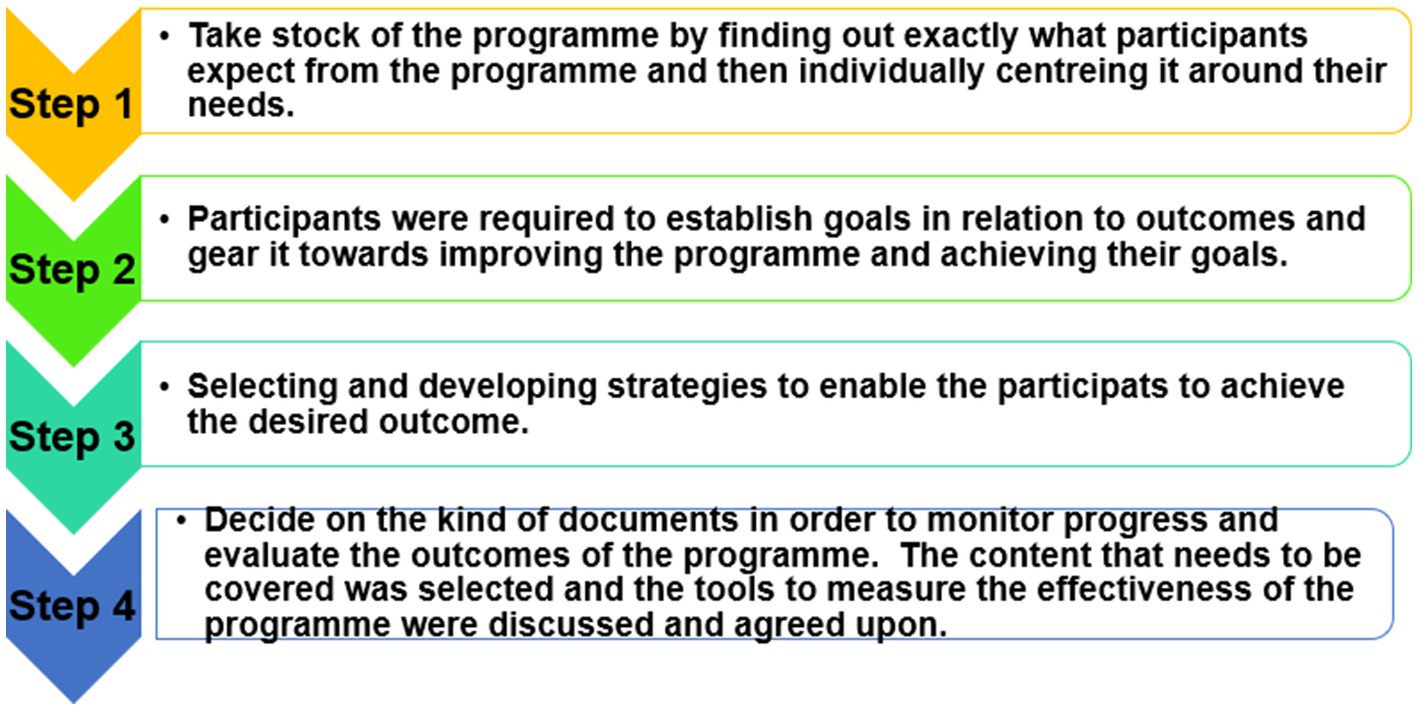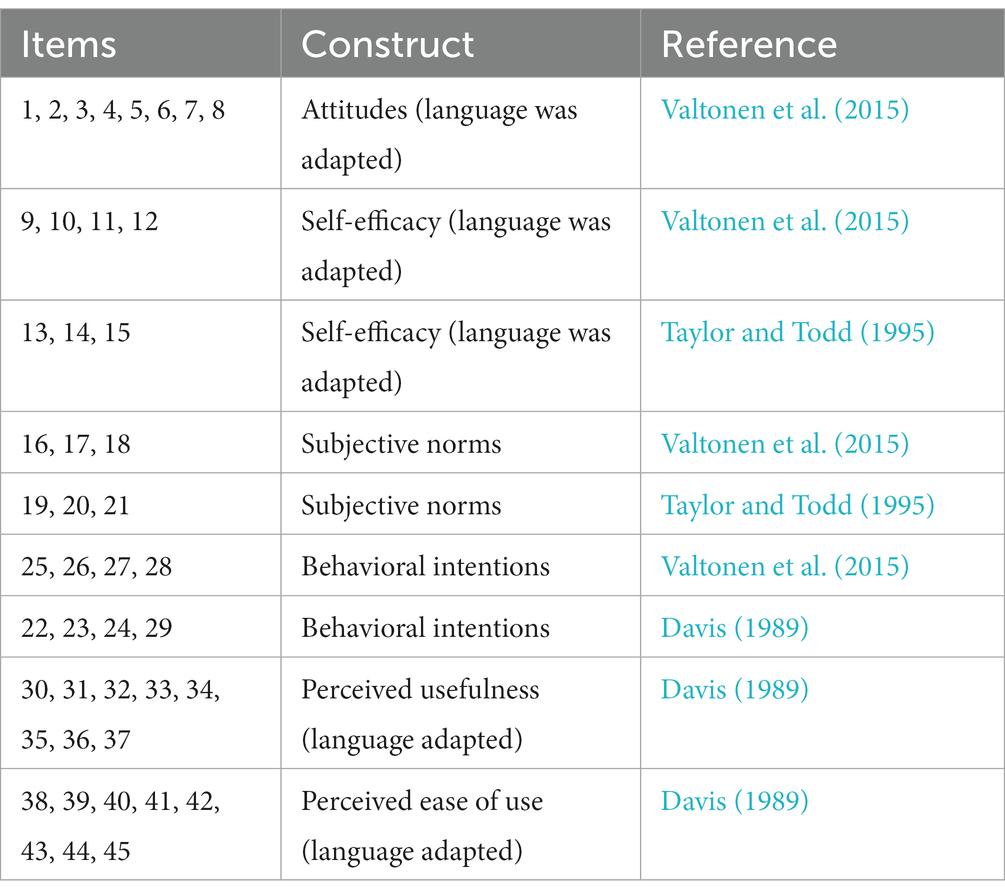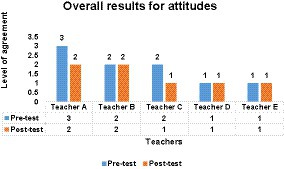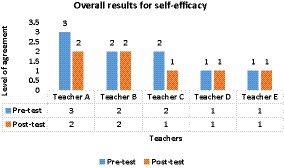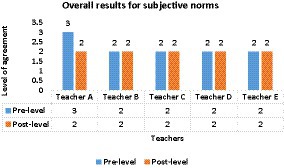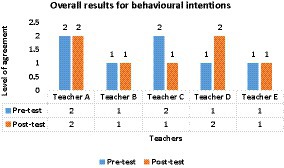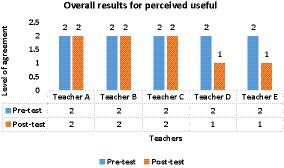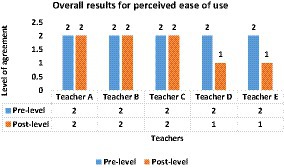- Department of Science and Technology Education, Faculty of Education, University of Johannesburg, Johannesburg, South Africa
The purpose of this research study was to investigate and determine the impact of teacher’s attitudes and beliefs on their behavioral intentions to integrate ICT into their science lessons and to establish the impact of a professional development program underpinned by the principles of empowerment evaluation (EE) on their attitudes and beliefs. The participants were selected from five high schools in Johannesburg, South Africa. A validated questionnaire was used to identify teachers’ attitudes and beliefs and to measure the impact of their attitudes and beliefs on their behavioral intentions to integrate ICTs into their science lessons. The findings from this research study indicated that the empowerment evaluation approach positively impacted the teacher’s attitudes and beliefs as well as improved their behavioral intentions to integrate ICT into their science lessons. Furthermore, this study revealed that the more confident and competent a teacher felt to integrate ICT into his/her lessons, the more likely he/she would be to integrate ICT into their lessons. Therefore, teachers’ behavioral intentions are important in predicting whether they will integrate ICT into their lessons.
1. Introduction
In South Africa, the White Paper on e-Education (Department of Education, 2004) advocates the pedagogical integration of ICT to promote the development of higher-order thinking skills. The Department of Basic Education through the Provincial Departments of Education has implemented programs to integrate ICT into the classroom of South African schools (Department of Education, 2004). The Gauteng Department of Education (GDE) has rolled out an ICT integration program to most of its township schools and conducted professional development sessions to train teachers on the use of technology in the classroom. Smartboards and other technological tools have been procured and delivered to school. However, research conducted on ICT integration in South African schools has indicated that although teachers have received adequate ICT integration training and resources, they still fail to integrate ICT into their lessons (Ndlovu and Lawrence, 2012; Mooketsi and Chigona, 2014; Mhlanga and Moloi, 2020; Mosehlana and Sebola, 2020; Aruleba and Jere, 2022; Shava, 2022; Crompton et al., 2023; Oki et al., 2023).
There are numerous studies conducted in South Africa that point to the benefits of ICT integration into the curriculum (e.g., Nkula and Krauss, 2014; Dlamini and Mbatha, 2018; Dube et al., 2018; Ostrowick, 2018; Mlambo et al., 2020; Aruleba and Jere, 2022; Crompton et al., 2023; Oki et al., 2023). However, the integration of ICT has been stifled due to various factors. Czerniewicz and Hodgkinson-Williams (2005) and Blignaut and Howie (2009) argue that the government in conjunction with the DBE has developed good policies with regard to the integration of ICT into the South African curriculum. They argue that the stumbling block seems to be the implementation. Thus far, the integration of ICT into the curriculum and effective management strategies for the successful implementation of ICT in all schools are yet to occur in the majority of South African schools (Czerniewicz and Hodgkinson-Williams, 2005; Blignaut and Howie, 2009; Oki et al., 2023). The implementation of ICT into the curriculum is dependent on three things. Firstly, there need to be policies that guide the integration of ICT into the curriculum. The second determinant is the preparedness of the teacher – the question needs to be asked: Do teachers have the required knowledge and skills to accomplish the task of integrating ICTs into their science lessons? Lastly, research indicates that teacher beliefs and attitudes influence their intentions to integrate ICT into the curriculum (Chikasha et al., 2014).
Research conducted in South Africa on the integration of ICT into the mathematics and science classrooms shows that teachers’ attitudes and beliefs influenced their use of ICT (Nkula and Krauss, 2014; Singh and Chan, 2014; du Plessis, 2016; George and Ogunniyi, 2016; Padayachee, 2017; Ostrowick, 2018; Graham et al., 2020; Aruleba and Jere, 2022; Saal and Graham, 2023). Teachers with technophobic tendencies tend to not use ICTs in their lessons, even when they have access to ICT resources and have received adequate training on ICT integration (George and Ogunniyi, 2016). George and Ogunniyi (2016) present the argument that even though the general assumption is that ICT resources will provide a platform for ICT integration, thus allowing both learners and teachers with a wide variety of opportunities to interact with ICT, there is still only a small percentage of teachers who have successfully integrated ICT into their lessons (George and Ogunniyi, 2016). Therefore, for effective ICT integration, there needs to be a willingness on the part of the teacher to use the available ICT resources. The effective utilization of the resources has the potential to lead to the successful integration of ICT into lessons but is largely dependent on the willingness of the teacher to make the shift from the traditional “talk and chalk” method of teaching to a more innovative approach that involves integrating ICT into the curriculum (Otto, 2021).
Teachers often “fear change” when confronted with having to acquire a new skill. There is often resistance from them due to the fact that they are “expected to lead developments when they are given insufficient long-term opportunities to make sense of the new technologies for themselves” (Mumtaz, 2000, p. 321). Pham and Phan (2023) identified this as especially evident during the COVID-19 pandemic, when teachers were forced to go from face-to-face teaching that they were familiar with to online teaching that the majority of them were not familiar with. They argue this transition triggered new emotional experiences for the teachers. These emotional experiences included fear and anxiety as they were required to learn new ways of teaching in a relatively short period of time (Petrie, 2020). To address this “fear of change,” Mumtaz (2000) and Fütterer et al. (2023) suggests that teachers be given time to attend professional development training opportunities that would expose them to the latest technologies available for teaching as well as to capacitate them to use the technology to positively impact their learners’ understanding of the complexed concepts in science.
This prompted this researcher to investigate and determine the impact of the physical sciences teacher’s attitudes and beliefs on their behavioral intentions to integrate ICT into their lessons.
2. Theoretical frameworks
Three theoretical frameworks anchored this research study. The first framework is the empowerment evaluation framework that was used to implement the professional development component of this study. The second and third frameworks are the Technology Acceptance Model (TAM) and the Theory of Planned Behavior (TPB). These two frameworks framed the inquiry into teachers’ attitudes and beliefs that determine their behavioral intentions to integrate ICT into their lessons.
2.1. Empowerment evaluation
Empowerment evaluation (EE) is the use of evaluation concepts, techniques and findings to foster improvement and self-determination (Fetterman, 2001). Its main focus is on the empowering process and the outcomes. It is designed to help people help themselves and improve their programs using a form of self-evaluation and reflection. The participants conduct their own evaluation, and an outside evaluator serves as a coach. This study used EE and in particular Fetterman (1996) four steps as illustrated in Figure 1 below as well as the 10 principles of EE to implement the ICT integration professional development program. These 10 principles are: improvement, inclusion, accountability, organizational learning, evidence-based strategies, social justice, community ownership, community knowledge, democratic participation, and capacity building (Fetterman and Wandersman, 2007). This professional development (PD) program served as an intervention, implemented in order to capacitate the teachers to integrate ICT into their lessons as well as to positively impact their attitudes and beliefs about ICT integration. It was hoped that the more competent and confident they felt, the more positive their attitudes and beliefs would be to integrate ICT into their lessons.
2.2. The technology acceptance model and the theory of planned behavior
The TAM was used in determining the impact of constructs on the behavioral intentions of teachers toward the acceptance of technological advancement. For this purpose, the contribution of attitudes of the users and their beliefs is regarded as considerable with respect to the notion of determining the instructional effectiveness, particularly in the domain of ICT integration.
The TPB is a theory which predicts deliberate behavior because behavior can be deliberate and planned. TPB suggests that the intentions of individuals are the proximal determinant of their behavior, with intentions as a concept to capture the motivation of an individual to perform a given behavior (Ajzen, 1991). The TPB asserts that behavioral intentions are jointly determined by attitudes toward the behavior, subjective norms and perceived behavioral controls. The stronger the intention of the individual to engage in a behavior, the more likely the individual would perform that behavior.
This research study employed the TAM and TPB models in order to assess the attitudinal behavior of Physical Sciences teachers toward the integration of ICT into their science lessons. In this regard, the core constructs of the models were used as the identified variables, including attitudes, self-efficacy, subjective norms, perceived usefulness, perceived ease of use, behavioral intentions and subjective norms. According to the results of the studies conducted there exist a significant association between the constructs under consideration (Venkatesh and Bala, 2008; Adetimirin, 2015; Tang et al., 2020; Oyunge, 2021; Badmus, 2022).
3. Methodology
3.1. Sampling
This study employed a case study design and was conducted with five in-service physical sciences teachers from schools in the Johannesburg region. The teachers who participated in the study had all taught physical sciences for at least five years and had taught at schools which were resourced with smartboards and other digital resources by the Gauteng Department of Education (GDE). The participants were purposefully chosen based on their eagerness to develop themselves in the use of ICT in their science lessons. At the same time, the sampling was convenient because all teachers were accessible to the researcher in terms of travel time and distance. This study was conducted during the COVID-19 pandemic when South Africa was under lockdown, the researcher was therefore forced to reduce the sample size in order to comply with lockdown regulations. Yin (2014) argues that not all investigations are conducted for the purposes of generalization. In the context of this research, the intention was not to generalize for the larger population but to explore the concept of EE as a method of PD.
As this study employed a case study design, it is important to have a profile of each participant to be able to understand the contextual factors that each of the participants was faced with. The participants were Teacher A, teacher B, Teacher C, Teacher D, and Teacher E.
3.2. Profile of the teachers
3.2.1. Profile of teacher A
Teacher A was the youngest of the five teachers. Her highest qualification was a BEd. (Hons) degree. A BEd. degree is an initial undergraduate degree in education which is followed by a BEd. (Hons) degree, which is a postgraduate degree in education that universities in South Africa offer to teachers. At the time of the study, she was the Grades 10–12 Physical Sciences teacher as well as the head of a department at her school. Her school was a quintile 1 school situated in Soweto. Quintile 1 schools are the schools situated in the most economically disadvantaged areas and are no-fee-paying schools (Dass and Rinquest, 2017). These schools are heavily subsidized by the Department of Basic Education (DBE) and parents are therefore not required to pay any school fees and all books, stationery and resources are provided by the DBE (Hall and Giese, 2008). Teacher A had 10 years of experience teaching Physical Sciences. She has attended training on the use of the smartboard and has used technology in her teaching for less than five years. She had access to one GDE supplied laptop that has a data card with 10 gigabytes of data, and her own personal smartphone in addition to a smartboard in her class. The school only had Wi-Fi connectivity in the office block for the principal, deputy principals and office staff. The teachers and learners had no access to the school’s Wi-Fi. The Grade 12 learners also did not have access to tablets. Prior to the ICT integration PD program, she considered herself a novice in the use of technology and basically used the smartboard mostly as a board to write on and occasionally project PowerPoint presentations.
3.2.2. Profile of teacher B
Teacher B trained as a teacher at the age of 35 after her children started school. Her highest qualification was a BEd. (Hon) degree. At the time of the study, she was a Physical Sciences and Natural Sciences teacher at a quintile 5 school and had 10 years of teaching experience. Quintile 5 schools are schools that are fairly well resourced and are situated in more affluent areas and receive less funding from the DBE (as opposed to quintile 1 schools) as they are fee-paying schools (Dass and Rinquest, 2017). Teacher B had access to one GDE supplied laptop and her own personal smartphone. Even though her school was ranked as a quintile 5 school, the school did not supply Wi-Fi to the learners or the teacher. The Wi-Fi was only for the senior management and office staff use. She too attended the GDE smartboard training and has also used technology in teaching for less than five years. She too had a smartboard in her classroom and used her personal smartphone as hotspot to provide her with an internet connection.
3.2.3. Profile of teacher C
Teacher C held a 4-year teacher’s diploma as well as an ACE in Physical Sciences. The ACE is an advanced certificate in education. Charles was a deputy principal at a quintile 1 school in Soweto. He had been teaching for 29 years and at the time of this study was teaching Physical Sciences and Natural Sciences. He had attended the smartboard training and has used technology in teaching for less than 5 years. He also had access to one GDE supplied laptop and his own smartphone. His school was situated in a very disadvantaged area and there was only Wi-Fi in the office block for senior management of the school and the admin staff. The school experienced electricity power outages regularly due to cable theft and load reduction instituted by Eskom, our electrical power supplier. Teacher C acknowledged that it was very difficult to teach with technology when electricity supply is a serious issue. He has smartboard in his classroom and also used his smartphone as a WIFI hotspot to provide him with an internet connection.
3.2.4. Profile of teacher D
Teacher D was a Physical Sciences teacher as well as a deputy principal at a quintile 4 school. Quintile 4, like quintile 5 schools, are situated in more affluent areas and are fee-paying schools. They receive a reduced subsidy from the DBE as parents are required to pay school fees (Dass and Rinquest, 2017). He had access to a department supplied laptop and his own smartphone. He too only had access to Wi-Fi in the office block as he was part of the senior management of the school. He also had a BEd. (Hon) and had 30 years of teaching experience. At the time of the study, he was teaching Natural Sciences and Physical Sciences. He had attended the smartboard training and has used technology for less than five years for teaching purposes. There was no Wi-Fi available for the learners or the teachers and the Grade 12 learners had access to department supplied tablets. He too had a smartboard in his classroom and used his personal data in order to use technology during his lessons.
3.2.5. Profile of teacher E
Teacher E had 32 years of teaching experience. She held a BEd. (Hon) degree and was a Physical Sciences and Natural Science teacher, who was also the head of the science department. Her school was ranked as a quintile 4 school. She did not have access to a GDE supplied laptop and her personal laptop was damaged. She did have access to her own personal smartphone. She also attended the smartboard training and in addition, she attended a Microsoft Office training workshop but did not complete all the modules. Even though it is ranked as quintile 4, her school was under-resourced and there was no Wi-Fi available for the teachers or the learners. Grade 12 learners were also not issued tablets. She had access to a smartboard in her class and used her smartphone as a WIFI hotspot in order to access the internet.
3.3. Questionnaire
This research study used a combination of two validated questionnaires. The first by Taylor and Todd (1995) and the second by Valtonen et al. (2015). The questionnaire was divided into six constructs that were based on the TAM and TPB frameworks. These constructs were: attitude, self-efficacy, subject norms, behavioral intentions, perceived usefulness and perceived ease of use. The questionnaire contained Likert-type statements (with a scale 1 = strongly agree and 5 = strongly disagree). Table 1 below indicates the items, the constructs and the references from where they were sourced.
3.4. Phases of the study
The study was divided into four phases. Phase 1 involved piloting the questionnaire, phase 2 involved administering the questionnaire to the five participants as a pre-test. Phase 3 involved implementing the ICT integration PD program that was used as an intervention. Lastly, phase 4 involved readministering the questionnaire as a post-test. The purpose of the pre-and post-test was to establish if the intervention was successful in positively impacting teacher’s attitudes and beliefs about ICT integration.
4. Results
The findings from the questionnaires were analyzed and the data presented below. The findings are classified according to the six constructs used in the questionnaire, namely attitude, self-efficacy, subject norms, behavioral intentions, perceived usefulness and perceived ease of use. For each of these constructs, we also report on shifts that took place as a result of the professional development intervention based on empowerment evaluation.
4.1. Attitudes
In this research study, attitudes toward ICT integration are defined as the degree to which a teacher believes that integrating ICT into the science classroom would have positive effects on their practices and would encourage them to increase the use of ICT in their lessons (Ajzen, 1991; Teo and Tan, 2012; Kemp et al., 2019; Granić, 2023). This construct comprised eight items that asked teachers to rate their responses to them as strongly agree, agree, neutral, strongly disagree or disagree.
The responses were coded and uploaded into an Excel spreadsheet where the average for the eight items for each teacher was calculated. The results were then graphically represented in Figure 2 below. The graph shows Teachers A and C had a change in their level of agreement. Teacher A moved from neutral to agreeing with the items. Teacher C shifted from agreeing with the items to strongly agreeing. For these two teachers, the intervention brought about a positive change in their attitudes toward ICT integration into their science lessons. Teachers B, D, and E showed no change in their attitudes after the intervention. Teacher B still agreed with all the items, while Teachers D and E still strongly agreed with the items. Even though the intervention had no effect on their agreement level, Teachers D and E already strongly agreed, so a shift was not necessary.
4.2. Self-efficacy
For the purposes of this research study, self-efficacy is defined as the degree to which a teacher would willingly explore and confidently introduce new technology into their science classroom in order to enhance learner understanding and performance (Ajzen, 1991; Teo et al., 2019; Granić, 2023; Rafique et al., 2023). The results are graphically represented in Figure 3 below. The graph shows Teachers A and C had a change in their level of agreement. Teacher A moved from neutral to agreeing with the items. Teacher C shifted from agreeing with the items to strongly agreeing. For these two teachers, the intervention brought about a positive change in their self-efficacy. They were more confident about integrating ICTs into their science lessons. Teachers B, D, and E showed no change in their self-efficacy after the intervention. Teacher B still agreed with all the items, while Teachers D and E still strongly agreed with the items.
4.3. Subject norms
In this research study, subjective norms are those influences exerted by colleagues, heads of department and other school stakeholders including the GDE and DBE officials on a teacher (Ajzen, 1991; Sun et al., 2020; Rejali et al., 2023). This construct was composed of six items that asked teachers to rate their responses.
The results are graphically represented in Figure 4 below. The graph shows Teacher A was the only one with a change in agreement level. She had a shift from neutral to agree. For Teacher A, the intervention brought about a change in her subjective norms. She was, therefore, more likely to be affected by external pressure from her superiors to integrate ICTs into her science lessons. Teachers B, C, D, and E showed no shift in their agreement levels. Their responses were to agree with the items. Therefore, the PD program had no effect on their subjective norms.
4.4. Behavioral intentions
Behavioral intentions are defined as the degree to which a teacher believes that integrating ICT into the science classroom would be beneficial to the teaching and learning process and would encourage teachers to increase their usage of ICTs (Ajzen, 1991; Fishbein & Ajzen, 2011; Wang et al., 2019; Rejali et al., 2023). This construct was composed of eight items that required teachers to rate their responses.
Figure 5 below graphically illustrates the results obtained. The graph shows Teachers C and D had a change in their level of agreement. Teacher C moved from agree to strongly agree for the items, while Teacher D moved from strongly agree to agree. For Teacher C, the intervention had a positive change in his behavioral intentions. The intervention for Teacher D had a negative effect as he shifted from strongly agree to just agree. Teachers A, B, and E showed no change in their agreement levels. Teacher A agreed to all the items, while Teachers B and E responded with strongly agree. From their responses, they were most likely willing to integrate ICTs into their lessons.
4.5. Perceived usefulness
In this research study perceived usefulness is defined as the degree to which a teacher believes that integrating ICT into the science classroom would enhance their job performance and enhance learner understanding of abstract concepts (Ajzen, 1991; Kemp et al., 2019; Teo et al., 2019; Rafique et al., 2023; Rejali et al., 2023; Zhang et al., 2023). This construct was composed of eight items.
The results are graphically represented in Figure 6 below. The graph shows Teachers D and E had a change in their level of agreement and shifted in their responses from agree to strongly agree. The intervention was able to get them to be more positive about integrating ICTs into their science lessons. Teachers A, B, and C showed no shift in their agreement levels. They responded by agreeing to all the items. The intervention had no impact on their perceived usefulness construct and the intervention was not able to shift them from agree to strongly agree.
4.6. Perceived ease of use
Gardner and Amoroso (2004) identify perceived ease of use as a core construct in the TAM and define it as the “degree to which an individual believes that using a particular system would be free of physical and mental effort” (p. 5). Chau (1996) and Granić (2023) argue that the perceived ease of use is important as it was found to influence not only teachers’ attitudes toward ICT, but also their behavior intention to use ICT and to also actually use ICT. In this research study, perceived ease of use is defined as the degree to which a teacher believes that integrating ICT into the science classroom would be a useful undertaking. This construct was composed of eight items.
The results are graphically represented in Figure 7 below. The graph shows Teachers D and E had a change in their level of agreement and they shifted from responding to agree to strongly agree. The intervention therefore had a positive impact as they now found it easy to integrate ICTs into their science lessons. Teachers A, B, and C showed no change in their agreement levels. They agreed with the items and the intervention had no impact on their agreement levels.
The results presented established that the PD program that encompassed the principles of empowerment evaluation was able to positively impact teacher’s attitudes and beliefs as well as their behavioral intentions to integrate ICT into their lessons.
5. Discussion
Research has established that having a more favorable attitude toward ICT integration leads to a stronger intention to integrate ICT into lessons (Davis, 1989; Gardner and Amoroso, 2004; Teo and Tan, 2012; Kemp et al., 2019; Granić, 2023). Therefore, for Teachers A and C the PD program that was underpinned by the principles of empowerment evaluation proved effective in positively altering teachers’ attitudes toward ICT integration. Teachers B, D, and E demonstrated no shift in their attitudes. Teachers D and E already strongly agreed to all the items, so no shift in their attitude was necessary. Teacher B remained on level 2, so the PD program was not able to bring about a positive shift in her attitude.
Research shows that the higher a teacher’s self-efficacy the more confident and willing they are to attempt new challenging opportunities (Davis, 1989; Gardner and Amoroso, 2004; Teo et al., 2019; Granić, 2023; Rafique et al., 2023). In this case, they would be more willing and confident to integrate ICT into their teaching of science. Therefore, for Teachers A and C the professional development program that was underpinned by the principles of empowerment evaluation proved effective in increasing the teachers’ self-efficacy and improving their behavioral intentions to integrate ICT into their science lessons.
In relation to subjective norms, the findings suggest that only Teacher A was positively impacted by the PD program, and this led to a positive change in how she views the influence of her superiors on behavioral intentions to integrate ICT into her science lessons (Ajzen, 1991; Sun et al., 2020; Rejali et al., 2023). Therefore, for Teacher A, the professional development program that was underpinned by the principles of empowerment evaluation proved effective in increasing her subjective norms, therefore improving her behavioral intentions to integrate ICT into her science lessons.
With regards to behavioral intentions, it can be concluded that only Teacher C was positively impacted by the professional development program, and this led to a positive change in how he views the benefits of integrating ICT into his lessons (Davis, 1989; Taylor and Todd, 1995; Gardner and Amoroso, 2004; Wang et al., 2019; Rejali et al., 2023). Therefore, for Teacher C the professional development program that was underpinned by the principles of empowerment evaluation proved effective in changing how he views the benefits of ICT integration into his science class. Research indicates that he would most probably be more willing to integrate ICT into his lessons (Davis, 1989; Taylor and Todd, 1995; Venkatesh and Davis, 2000; Gardner and Amoroso, 2004; Wang et al., 2019; Rejali et al., 2023).
Research has established that the more a teacher perceives ICT to be useful, the more they will believe that it has the ability to enhance both their job performance and their learners’ understanding (Davis, 1989; Gardner and Amoroso, 2004; Kemp et al., 2019; Teo et al., 2019; Granić, 2023; Rafique et al., 2023; Rejali et al., 2023; Zhang et al., 2023). Therefore, for Teachers D and E the professional development program that was underpinned by the principles of empowerment evaluation proved effective in increasing the perception of the useful benefits of ICT integration into their science lessons.
In terms of perceived ease of use, it can be concluded that for Teachers D and E the professional development program that was underpinned by the principles of empowerment evaluation proved effective in increasing their beliefs that integrating ICT into their science lessons is a useful undertaking.
6. Limitations
This study was subjected to some limitations. Firstly, this study was conducted in the heart of the COVID-19 pandemic which placed many restrictions both on the researcher and the participants. There were also strict policies on access to the school premises and for a while, all meetings and even small gatherings were prohibited.
Secondly, this study was originally going to commence with 100 participants, but due to the pandemic, the researcher was forced to reduce the sample size and the study commenced with seven teachers. During the course of the study, one participant was forced to withdraw due to ill health caused by COVID-19 and a second participant passed on due to COVID-19 complications. The research study then continued with only five participants.
Thirdly, EE is a labor-intensive approach, and it requires a large investment in time (Fetterman, 1999). The researcher found that working individually with five participants was taxing on both her time, resources and budget. It was also taxing on the participants as they had to sacrifice a large amount of time in order to participate in the PD program.
Fourthly, the pandemic caused the researcher to experience setbacks. These setbacks included having to put the study on hold during the hard lockdown period when schools were closed. Also, some of the participants tested positive and were off work for at least 10 days, delaying the progress of this study. Lastly if this study was conducted prior to COVID-19 pandemic a larger sample size could have been used and inferential statistics could have been used to ascertain significant differences for attitudes and beliefs pre- and post- intervention.
7. Suggestions for future studies
Future research could build on this study and investigate the impact EE could make on a larger sample of teachers within a community of practice at schools and within a cluster of schools. From the results of this study, it was found that working on a one-on-one basis with teachers worked really well as the teachers were able to work at their own pace and practice a skill with the help of the researcher until they mastered that skill. This would not have been possible if the PD program took place with a group of teachers. Also, the teachers were part of the decision-making process; they decided what knowledge and skills they wanted to acquire and at what pace they wanted to proceed. In addition, they set goals that they worked toward achieving. This study’s PD program strictly adhered to the 10 principles of EE as well as the EE four-step implementation program.
The results of this study could encourage teachers to initiate communities of practice within their schools and within clusters of schools in their areas in order to create EE pairs. Within these communities, senior experienced teachers who have a proven track record of successfully integrating ICT into their lessons can be approached to act as evaluators. The purpose of the evaluator is to guide the teacher to identify their PD needs and then to assist them to set goals in order to address the needs identified. The evaluator would then, together with the teacher, set up PD opportunities to guide the teacher to achieving their goals. The evaluator as well as the teachers would require the school management’s support in order to successfully implement this program. In this way we would get more teachers being capacitated to effectively integrate ICT into their lessons. It is hoped that once they are confident and competent in integrating ICT, it would change their attitudes and beliefs about ICT integration, thus resulting in them being more willing to integrate it into their lessons.
8. Conclusion
From the findings presented, it can be concluded that the researcher was able to establish that the professional development program that adopted an empowerment evaluation approach was successful in positively impacting the attitudes and beliefs of the teachers, which in turn positively impacted their behavioral intentions to integrate ICT into their lessons. Furthermore, this study revealed that the more confident and competent a teacher felt to integrate ICT into his/her lessons, the more likely he/she would be to integrate ICT into their lessons. Therefore, the teachers’ behavioral intentions are important in predicting whether they will integrate ICT into their lessons. A review of the literature on teachers’ behavioral intentions and these six constructs, the findings from this study’s teacher attitudes and beliefs questionnaire and the interview data, suggest that they are influenced by the following constructs: teachers’ attitudes, self-efficacy, subjective norms, behavioral intentions, perceived usefulness and perceived ease of use (Ajzen, 1991; Lee et al., 2010; Teo and Tan, 2012; Zhou et al., 2016; Kemp et al., 2019; Teo et al., 2019; Wang et al., 2019; Sun et al., 2020; Granić, 2023; Rafique et al., 2023; Rejali et al., 2023; Zhang et al., 2023). The research conducted further suggests that these constructs are responsible for determining a teacher’s behavioral intentions to integrate ICT into their science lessons. If teachers are not positive about ICT integration, they are less likely to willingly integrate ICT into their lessons.
Data availability statement
The original contributions presented in the study are included in the article/supplementary material, further inquiries can be directed to the corresponding author.
Author contributions
All authors listed have made a substantial, direct, and intellectual contribution to the work and approved it for publication.
Conflict of Interest
The authors declare that the research was conducted in the absence of any commercial or financial relationships that could be construed as a potential conflict of interest.
Publisher’s note
All claims expressed in this article are solely those of the authors and do not necessarily represent those of their affiliated organizations, or those of the publisher, the editors and the reviewers. Any product that may be evaluated in this article, or claim that may be made by its manufacturer, is not guaranteed or endorsed by the publisher.
References
Adetimirin, A. (2015). An empirical study of online discussion forums by library and information science postgraduate students using technology acceptance model 3. J. Inform. Technol. Educ. Res. 14, 257–269. doi: 10.28945/2269
Ajzen, I. (1991). The theory of planned behaviour. Organ. Behav. Hum. Decis. Processes 50, 179–211. doi: 10.1016/0749-5978(91)90020-T
Aruleba, K., and Jere, N. (2022). Exploring digital transforming challenges in rural areas of South Africa through a systematic review of empirical studies. Sci. Afr. 16:e01190. doi: 10.1016/j.sciaf.2022.e01190
Badmus, A. M. (2022). Teachers’ perceived usefulness, ease of use, and challenges with e-learning utilization sustainability after COVID-19 pandemic in Oyo State, Nigeria. J. Educ. Black Sea Region 8, 38–46. doi: 10.31578/jebs.v8i1.275
Blignaut, S., and Howie, S. J. (2009). National policies and practices on ICT in education: South Africa. Cross Natl ICT Policies Pract. Educ., 14, 345–363. doi: 10.1007/s10639-009-9105-0
Chau, P. Y. (1996). An empirical assessment of a modified technology acceptance model. J. Manag. Inf. Syst. 13, 185–204. doi: 10.1080/07421222.1996.11518128
Chikasha, S., Ntuli, M., Sundarjee, R., and Chikasha, J. (2014). ICT integration in teaching: An uncomfortable zone for teachers: A case of schools in Johannesburg. Educ. Change 18, 137–150. doi: 10.1080/16823206.2013.847013
Crompton, H., Chigona, A., and Burke, D. (2023). Teacher resilience during COVID-19: comparing teachers’ shift to online learning in South Africa and the United States. TechTrends, 67, 1–14. doi: 10.1007/s11528-022-00826-6
Czerniewicz, L., and Hodgkinson-Williams, C. (2005). Education in South Africa-what have ICTs got to do with it? Perspect. Educ. 23, VII–XIV.
Dass, S., and Rinquest, A. (2017). “School fees” in Basic education rights handbook: Education rights in South Africa. eds. F. Veriava, A. Thom, and T. F. Hodgson (Johannesburg, South Africa: Department of Education), 140–159.
Davis, F. D. (1989). Perceived usefulness, perceived ease of use, and user acceptance of information technology. MIS Q., 13, 319–340. doi: 10.2307/249008
Department of Education (2004). White Paper on e-Education, transforming learning and teaching through Information and Communication Technology (ITCs) Pretoria: Government Printers.
Dlamini, R., and Mbatha, K. (2018). The discourse on ICT teacher professional development needs: The case of a South African teachers’ union. Int. J. Educ. Dev. Using ICT 14, 17–37.
Dlodlo, N. (2010). Access to ICT education for girls and women in rural South Africa: A case study. Council Sci. Indust. Res. 21, 12–56. doi: 10.1016/j.techsoc.2009.03.003
du Plessis, A. (2016). Student-teachers’ pedagogical beliefs: learner-centred or teacher-centred when using ICT in the science classroom? J. Balt. Sci. Educ. 15, 140–158. doi: 10.33225/jbse/16.15.140
Dube, B. A., Nhamo, E., and Magonde, S. (2018). Factors affecting ICT integration in the teaching and learning of physical education in South Africa: A case of Johannesburg east cluster primary schools in the Gauteng province. Int. J. Sport Exerc. Health Res. 2, 88–92. doi: 10.31254/sportmed.2103
Fetterman, D. M. (1996). “Empowerment Evaluation: An Introduction to Theory and Practice” in Empowerment Evaluation: Knowledge and Tools for Self-Assessment & Accountability. eds. D. M. Fetterman, S. J. Kaftarian, and A. Wandersman (Thousand Oaks, CA: Sage), 3–27.
Fetterman, D. M. (1999). Reflections on empowerment evaluation: Learning from experience. The Canadian Journal of Program Evaluation, 14, 179–198.
Fetterman, D., and Wandersman, A. (2007). Empowerment evaluation: yesterday, today, and tomorrow. Am. J. Eval. 28, 179–198. doi: 10.1177/1098214007301350
Fishbein, M., and Ajzen, I. (2011). Predicting and changing behavior: The reasoned action approach. Taylor and Francis.
Fütterer, T., Scherer, R., Scheiter, K., Stürmer, K., and Lachner, A. (2023). Will, skills, or conscientiousness: what predicts teachers’ intentions to participate in technology-related professional development? Comput. Educ. 198:104756. doi: 10.1016/j.compedu.2023.104756
Gardner, C., and Amoroso, D. L. (2004). Development of an instrument to measure the acceptance of internet technology by consumers. In Proceeding of the 37th Annual Hawaii International Conference on System Sciences
George, F., and Ogunniyi, M. (2016). Teachers’ perceptions on the use of ICT in a CAL environment to enhance the conception of science concepts. Univ. J. Educ. Res. 4, 151–156. doi: 10.13189/ujer.2016.040119
Graham, M. A., Stols, G., and Kapp, R. (2020). Teacher practice and integration of ICT: Why are or aren’t South African teachers using ICTs in their classrooms. Int. J. Instr. 13, 749–766. doi: 10.29333/iji.2020.13251a
Granić, A. (2023). “Technology acceptance and adoption in education” in Handbook of Open, Distance and Digital Education (Springer Nature Singapore: Singapore), 183–197.
Hall, K., and Giese, S. (2009). Addressing quality through school fees and school funding: Meaningful access to basic education-part two. South African Child Gauge. 1, 35–40.
Kemp, A., Palmer, E., and Strelan, P. (2019). A taxonomy of factors affecting attitudes towards educational technologies for use with technology acceptance models. Br. J. Educ. Technol. 50, 2394–2413. doi: 10.1111/bjet.12833
Lee, J., and Cerreto, F. A., and Lee, J. (2010). Theory of planned behavior and teachers’ decisions regarding use of educational technology. J Educ Techno Soc. 13, 152–164.
Mhlanga, D., and Moloi, T. (2020). COVID-19 and the digital transformation of education: What are we learning on 4IR in South Africa? Educ Sci 10:180. doi: 10.3390/educsci10070180
Mlambo, S., Rambe, P., and Schlebusch, L. (2020). Effects of Gauteng province’s educators’ ICT self-efficacy on their pedagogical use of ICTS in classrooms. Heliyon 6, e03730–e03714. doi: 10.1016/j.heliyon.2020.e03730
Mooketsi, B. E., and Chigona, W. (2014). Different shades of success: Educator perceptions of government strategy on E-Education in South Africa. Electron J. Inform. Syst. Develop. Countries 64, 1–15. doi: 10.1002/j.1681-4835.2014.tb00461.x
Mosehlana, M. B., and Sebola, M. P. (2020). Assessment of the implementation of the’ digital classroom’ initiative in the Gauteng Provincial Department of Basic Education. International Conference on Public Administration and Development Alternatives (IPADA).
Mumtaz, S. (2000). Factors affecting teachers' use of information and communications technology: a review of the literature. J. Inf. Technol. Teach. Educ. 9, 319–342. doi: 10.1080/14759390000200096
Ndlovu, N. S., and Lawrence, D. (2012). The quality of ICT use in South African classrooms. Towards Carnegie III: Strategies to Overcome Poverty & Inequality, Cape Town, 3–7. South Africa: University of Cape Town 1-26.
Nkula, K., and Krauss, K. E. (2014). The integration of ICTs in marginalized schools in South Africa: considerations for understanding the perceptions of in-service teachers and the role of training. In Proceeding of the International Development Informatics Association (IDIA) Conference, 3.
Oki, O. A., Uleanya, C., and Mbanga, S. (2023). Echoing the effect of information and communications technology on rural education development. Technol. Audit Product. Res. 1:69. doi: 10.15587/2706-5448.2023.269698
Ostrowick, J., (2018). Empowering teachers to use ICTs in South Africa. Available at: (https://iite.unesco.org/wp-content/uploads/2018/05/John-Ostrowick-Teachers-and-ICTs-in-South-Africa.pdf).
Otto, D. (2021). Driven by emotions! the effect of attitudes on intention and behaviour regarding open educational resources (OER). J. Interact. Media Educ. 2021. 1, 1–14. doi: 10.5334/jime.606
Oyunge, T. O. (2021). Exploring secondary school teachers’ pedagogical beliefs and the integration of ICT in the context of a developing country: a technology acceptance model perspective. Eur. J. Educ. Stud. 8, 206–237. doi: 10.46827/ejesv8i3.3639
Padayachee, K. (2017). The myths and realities of generational cohort theory on ICT integration in education: A South African perspective. Afr. J. Inform. Syst. 10, 4–29.
Petrie, C. (2020). Current opportunities and challenges on Covid-19 in education. Spotlight: Quality education for all during Covid-19 crisis. OECD/Hundred Research Report #011.
Pham, L. T. T., and Phan, A. N. Q. (2023). Let’s accept it: Vietnamese university language teachers’ emotion in online synchronous teaching in response to COVID-19. Educ. Develop. Psychol. 40, 115–124. doi: 10.1080/20590776.2021.2000321
Rafique, H., Ul Islam, Z., and Shamim, A. (2023). Acceptance of e-learning technology by government school teachers: application of extended technology acceptance model. Interact. Learn. Environ. 1, 1–19. doi: 10.1080/10494820.2022.2164783
Rejali, S., Aghabayk, K., Esmaeli, S., and Shiwakoti, N. (2023). Comparison of technology acceptance model, theory of planned behavior, and unified theory of acceptance and use of technology to assess a priori acceptance of fully automated vehicles. Transp. Res. A Policy Pract. 168:103565. doi: 10.1016/j.tra.2022.103565
Saal, P. E., and Graham, M. A. (2023). Comparing the use of educational technology in mathematics education between South African and German schools. Sustainability 15:4798. doi: 10.3390/su15064798
Shava, E. (2022). Reinforcing the role of ICT in enhancing teaching and learning post-COVID-19 in tertiary institutions in South Africa. J. Cult. Values Educ. 5, 78–91. doi: 10.46303/jcve.2022.7
Singh, T. K. R., and Chan, S. (2014). Teacher readiness on ICT integration in teaching-learning: a Malaysian case study. Int. J. Asian Soc. Sci. 4, 874–885.
Sun, S., Law, R., and Schuckert, M. (2020). Mediating effects of attitude, subjective norms and perceived behavioural control for mobile payment-based hotel reservations. Int. J. Hosp. Manag. 84:102331. doi: 10.1016/j.ijhm.2019.102331
Tang, H., Lin, Y. J., and Qian, Y. (2020). Understanding K-12 teachers’ intention to adopt open educational resources: A mixed methods inquiry. Br. J. Educ. Technol. 51, 2558–2572. doi: 10.1111/bjet.12937
Taylor, S., and Todd, P. (1995). Decomposition and crossover effects in the theory of planned behavior: A study of consumer adoption intentions. Int. J. Res. Mark. 12, 137–155. doi: 10.1016/0167-8116(94)00019-K
Teo, T., Sang, G., Mei, B., and Hoi, C. K. W. (2019). Investigating pre-service teachers’ acceptance of Web 2.0 technologies in their future teaching: a Chinese perspective. Interact. Learn. Environ. 27, 530–546. doi: 10.1080/10494820.2018.1489290
Teo, T., and Tan, L. (2012). The theory of planned behavior (TPB) and pre-service teachers’ technology acceptance: a validation study using structural equation modelling. J. Technol. Teach. Educ. 20, 89–104.
Valtonen, T., Kukkonen, J., Kontkanen, S., Sormunen, K., Dillon, P., and Sointu, E. (2015). The impact of authentic learning experiences with ICT on pre-service teachers' intentions to use ICT for teaching and learning. Comput. Educ. 81, 49–58. doi: 10.1016/j.compedu.2014.09.008
Venkatesh, V., and Bala, H. (2008). Technology acceptance model 3 and a research agenda on interventions. Decis. Sci. 39, 273–315. doi: 10.1111/j.1540-5915.2008.00192.x
Venkatesh, V., and Davis, F. D. (2000). A theoretical extension of the technology acceptance model: four longitudinal field studies. Manag. Sci. 46, 186–204. doi: 10.1287/mnsc.46.2.186.11926
Wang, J., Tigelaar, D. E., and Admiraal, W. (2019). Connecting rural schools to quality education: Rural teachers’ use of digital educational resources. Comput. Hum. Behav. 101, 68–76. doi: 10.1016/j.chb.2019.07.009
Zhang, Z., Maeda, Y., Newby, T., Cheng, Z., and Xu, Q. (2023). The effect of preservice teachers’ ICT integration self-efficacy beliefs on their ICT competencies: The mediating role of online self-regulated learning strategies. Comput. Educ. 193:104673. doi: 10.1016/j.compedu.2022.104673
Keywords: empowerment evaluation, professional development, teachers’ beliefs, attitudes, ICT integration, science education, theory of planned behavior, technology acceptance model
Citation: Moosa S and Ramnarain U (2023) The impact of an empowerment evaluation professional development program on physical sciences teachers’ attitudes, beliefs and behavioral intentions to integrate ICT into their science lessons. Front. Educ. 8:1159373. doi: 10.3389/feduc.2023.1159373
Edited by:
Fika Megawati, Universitas Muhammadiyah Sidoarjo, IndonesiaReviewed by:
Ana Manzano-León, University of Almeria, SpainHariharan N. Krishnasamy, Universiti Utara Malaysia, Malaysia
Copyright © 2023 Moosa and Ramnarain. This is an open-access article distributed under the terms of the Creative Commons Attribution License (CC BY). The use, distribution or reproduction in other forums is permitted, provided the original author(s) and the copyright owner(s) are credited and that the original publication in this journal is cited, in accordance with accepted academic practice. No use, distribution or reproduction is permitted which does not comply with these terms.
*Correspondence: Umesh Ramnarain, dXJhbW5hcmFpbkB1ai5hYy56YQ==
 Sumayya Moosa
Sumayya Moosa Umesh Ramnarain
Umesh Ramnarain